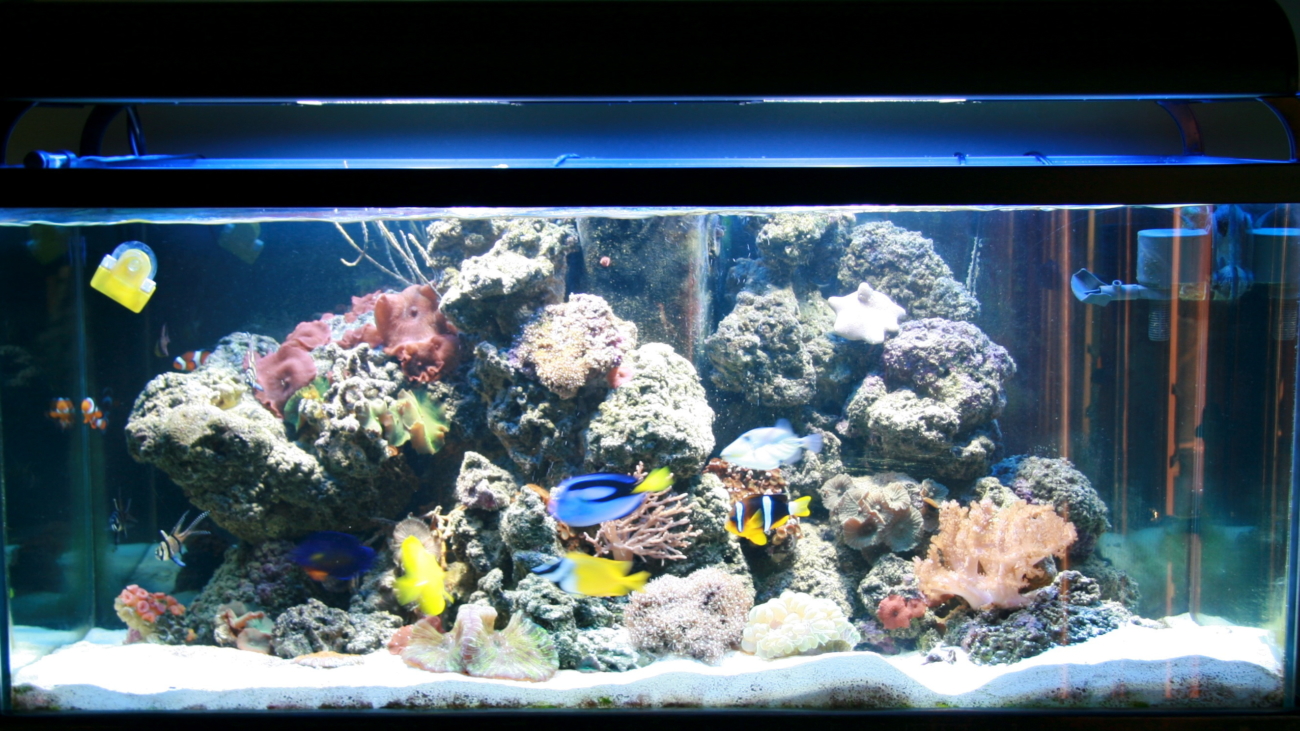One of the unintended consequences that I’ve experienced as a result of the COVID pandemic is an increase in interest for my reef aquarium. Yes, I’ve kept saltwater fish and corals for most of adult life, but as I’ve been stuck at home a lot more over the last 10 months, I’ve really put a lot of time and thought into my reef aquarium. I thought I’d dedicate this blog post to my thoughts on keeping corals…
Most of the corals we keep in our home aquariums are photosynthetic, meaning they derive a good percentage of their nutrition from light. You can supplement feed them if you wish (more on this below), but no amount of feeding will replace good lighting. Corals contain stinging cells called nematocysts, so it’s important to give them the space they need (ie. don’t overcrowd them). And not all fish are compatible with corals, so keep that in mind when you’re planning your tank (yes, you should plan it out ahead of time).
Lighting
As mentioned above, most of the corals available to the aquarium trade are photosynthetic. In fact, a home aquarist really should never attempt to keep a non-photosynthetic coral, as their feeding requirements are typically too specific for the average reef enthusiast.
You may have heard that all corals require a TON of light. In fact, that’s simply not true. Many soft corals and LPS (Large Polyp Stony) corals do best in lower lighting conditions. For that reason, many reefers keep their LPS corals on the sand bed, where the light is least intense. Higher light corals like SPS (Small Polyp Stony) and Tridacna clams require much more intense lighting, and should be placed at the top of the tank.
Lighting adheres to the inverse square law, so as you move twice as far from a light source, you get one quarter of the intensity. In that regard, with today’s powerful LED lighting systems, you can keep a great variety of corals in your tank. Lower light corals like LPS near the bottom, and higher light corals like SPS at the top.
Water Flow
All corals require some degree of water movement. They cannot do well in stagnant conditions. Water flow prevents detritus from accumulating on the corals, as well as bringing them much-needed food and trace elements while whisking away waste products.
Similar to lighting, different corals require different levels of water movement to thrive in the aquarium. Using the above examples, most LPS corals do better in low to moderate water flow, which you typically find at the bottom of the tank. SPS corals almost universally require high water flow, which you usually find at the top of the tank. Just like with lighting, using this formula you can keep a wide variety of corals in your tank.
Feeding
Corals are animals, and as such they need to eat. We’ve already covered that the corals in your tank will be photosynthetic, and derive much of their required nutrition from your full-spectrum light. So do you need to supplement their diet with coral food? The answer depends on the type of coral and your tank.
LPS corals have large mouths, and they like to eat (and it’s really cool to watch them pass the food down their tentacles and into their mouths). They can be fed meaty foods like krill and shrimp, but I’ve found they actually like pellet food the best. Having said that, it’s not necessary to go out of your way to feed LPS corals. They typically do just fine with good lighting and a small level of nitrate and phosphate in the water (if you have fish in your tank, that shouldn’t be a problem). If you want to supplement their diet with a little food once a week, that’s fine, just be careful as it can lead to pollution in your tank.
I have never gone out of my way to feed SPS corals. They have tiny polyps with incredibly tiny mouths, and any food larger than plankton cannot be taken-in by the coral. You can dose phytoplankton to the tank if you wish, and there is some benefit to doing so, but you can easily overdo it. I add a little phytoplankton once per week to my reef tank, but no more than that.
Aquarium maintenance
Corals are much less tolerant of water chemistry changes than fish are. They require high quality water with salinity, temperature, and pH in a very small range. They also require the regular supplementation of calcium, magnesium, and carbonate to build their skeletons and keep them healthy.
Frequent partial water changes using purified RODI water, constant protein skimming, and even the use of nitrate and phosphate reducing media will go a long way towards keeping them healthy. Reef tanks are never set-it and forget-it operations. But having said that, technology has really made keeping corals much easier in the last decade.
Fish
It’s nice to see a group of fish swimming amongst the corals. That’s the aspirational tank that most of us dream of. Having said that, you have to be a little careful with keeping fish in your reef aquarium.
For starters, some fish eat coral. Angels (both large and small), puffers, and triggers can all wreak havoc on a reef aquarium. Best to leave those in a fish only tank. Tangs, clownfish, rabbitfish, and damsels are all good choices.
Even if you select reef-safe fish, you have to watch out for the pollution they can cause. All fish need to be fed, and all fish pee and poop in the water. Uneaten food and fish waste will break down in your tank and degrade your water quality. The nutrient export methods above will counteract that process, but it is easily possible to overwhelm your ability to remove excess nutrients from the tank. For that reason, keep your fish stocking levels lower and feed sparingly. Your fish and corals will be much happier that way.
That just about does it for my primer on keeping corals in your home aquarium. With a decent budget and regular tank maintenance, you too can have a slice of the ocean in your living room.


